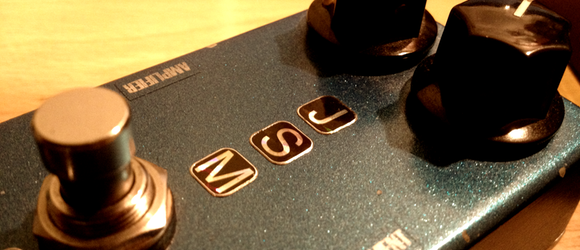Fuzz
I have been mad about fuzz—the electric guitar effect—ever since I first plugged into a reissue of the venerable olive green russian Big Muff eight years ago. One of the oldest effects around, it is also one of the most diverse, and potentially daunting. Popular fuzz circuits trace lineage back to the 1960s. The simplicity of those circuits, and the variability of the analog components used, has lead to a combinatorial explosion of possibilities.
My early preconceptions of fuzz were that it was at the far end of the crunch spectrum, far beyond distortion. In reality fuzz is much more than just more. Fuzz spans a spectrum of sounds from not much more than adding grit and volume to a clean guitar, through chewy snarled-up bite and into wooly, uncompromising roar. Theres no right way to build or use a fuzz, and that is part of the fun.
My initial foray into fuzz was tainted by my fascination with trying to reproduce the unsubtle sounds found on Smashing Pumpkins tracks. The gigantic, wooly sound of that green big muff in isolation was astounding, but, like so many inexperienced guitarists, when I tried to use it in the context of a band it was thunderous and indistinct: nobody could hear guitar, but everyone was deafened by it. I soon gave up on the muff, but by then the sound of fuzz was in my head. I kept searching for a fuzz that I could use.

The first fuzz that really clicked for me was a variant on the classic Fuzz Face, the other well known family outside of the Muff. This pedal was built by a guy called Paul in Auckland who was building pedals as Fuzzie Bro and selling them online. I bought a prototype clone of a japanese Fuzz Face clone (the Shin-ei Companion Fuzz) that Paul was calling the Japanese Saturation Machine (JSM). A friend described it as a nintendo having a fit. That pedal was stolen later that year, so I commissioned Paul to build a replacement, but with some tweaks. The original pedal used two silicon transistors but, inspired by the Beavis Audio FuzzLab and its Fuzz Face stage, I had one side of the circuit use a germanium transistori. The resulting pedal has a snarling, gravelly sound.
In isolation the JSM is hard to listen to; harsh, abbrasive and even a little raspy or metalic. In the context of the band its excellent. The fuzz occupies its own space in the sound of the band, and it complements the other instruments. This is one aspect of many fuzzes that make them hard to approach for unfamiliar playersii. Fuzz is something of a contradiction; broken up sound that fits nicely within a band context.
Despite simple circuits and controls, a good fuzz is a complex beast that responds dynamically to the controls and pickups on the guitar as well as playing. It can be rhythmic and textural, or a sizzling lead sound, and is as comfortable in country and pop as in alt rock and metal. It just feels different to play fuzzed guitar. No matter how much you understand this intellectually, there is still a learning curve in practise. The deconstructed sound means that no matter how weird a pedal gets, there is someone who can find a use for it. It is impossible to award a box the best fuzz moniker; find a fuzz that works for you and experiment.
- I have since learn't that this configuration is known as a ‘hybrid’ fuzz.
- The abrasive sound of fuzz is exaggerated by cheap guitars and amps, especially the low end solid state amps. They become practically unusable.